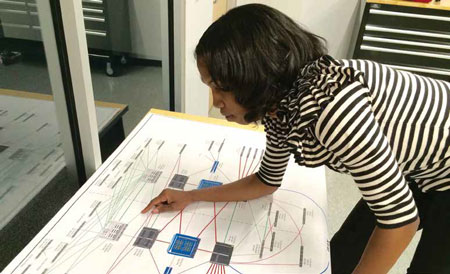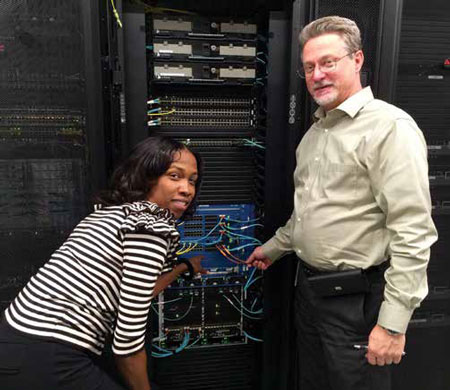Fulton Schools Deploy Software-Defined Networks in New Data Center

Fulton County (GA) Schools in metro Atlanta has jumped feet first into the latest technology, deploying Software-Defined Networks (SDN) in its new data center. Formerly housed in an old high school building in the southern end of the district, our new state-of-the-art data center includes all new hardware and technology. We invested in the most cutting-edge equipment that our server vendors could provide, including energy-efficient cooling components for the hardware racks and a brand new VMware NSX technology software system. It’s not enough to deliver services and storage and computer power at the level that we used to. We need to utilize the most advanced tools as they become available.
A GREENFIELD OPPORTUNITY
Fulton Schools’ Chinique Griffin looks over the network configuration chart. For a network upgrade of such a large scale, the opportunity to build a customized data center from the ground up was a major opportunity. Transitioning to a new software system inside the previous physical space would have required compromises and reusing hardware that was not quite right for the job. It’s a greenfield opportunity to build something from the ground up—a best-case, non-compromised start to a software-defined network.

As Fulton boldly delves into SDN, security continues to be our number one priority. My job is to keep our district out of the news. SDNs make security very granular and personal to the environment. The new technology addresses security concerns by allowing my IT team to respond more quickly and dynamically to the needs of our customers. We can make changes remotely and on the fly, allowing for more security and flexibility when students and teachers use applications.
DRIVEN TO INNOVATE
The new system fits in well with our strategic plan, which lists student access to technology as a strategic initiative. The district is on the verge of deploying individual tablet devices to every middle and high school student as part of its personalized learning plan. That alone requires 60,000 personalized devices all working at the same time in different classrooms, so a robust infrastructure is necessary to support it. Students’ demand for technology is driving us to innovate to try to keep up.
Tech specialist Chinique Griffin and Kenny Wilder, director of IT infrastructure, show off the new SDN data center. The district spent approximately $8 million to complete the build-out and fill the new space with appropriate hardware and software. Funding for the project came almost entirely from Fulton County’s one-cent, special-purpose, local-option sales tax construction and technology budget.
Tools and ideas to transform education. Sign up below.

As a charter district, each of our 101 schools has vastly different needs and progresses at different rates. Using SDN technology allows our server-side technicians to respond to individual needs and paces by manipulating infrastructure much faster. By storing information inside a private cloud, opening an application is a faster process for students, and it’s much easier for teachers and applications to acquire information about a student and record his or her progress.
It used to take us three to six weeks to deploy a server with our old processes, but now with SDN and a private cloud we can do it in three to six hours. Overall, SDN allows schools to make their own diverse choices and the network adapts to them rapidly. More important, it increases overall up time and availability of the network. The new technology minimizes classroom interruptions due to technology mishaps. If any part of the network falters, technicians can quickly manage problems from a centralized console, eliminating the need to send someone to a wiring closet at the school.
GROWING PAINS
Although the benefits of upgrading to a SDN network are manifold, Fulton is one of the first organizations brave enough to fully embrace the system. As a result, installing the system has been a tedious, isolating process. We are now on the absolute bleeding edge of implementing SDN and the technology we put in the network. We have gone through some growing pains along the way, such as finding technicians who even know how to set it up.
Manufacturers and vendors all agree that upgrading to SDN is a wonderful idea, but when it comes to implementing it, in our experience manufacturers are still figuring it out themselves. Still, we stand by our decision to jump from the more conservative cutting edge up to the bleeding edge of tech adoption. Using an SDN network lets us keep things up and running, improves delivery of technology for classroom instruction, and drastically reduces our downtime.
The district has a reputation for being a leader in embracing technology, and the key to succeeding seems to be patience. When dealing with SDN in particular, it is wise for an organization to give itself a long lead time to get it up and running. Along the way, you must have good relationships with vendors and aim to design the installation from the ground up, with a minimum of compromises.
Kenny Wilder is director of IT infrastructure at Fulton County (GA) Schools.
